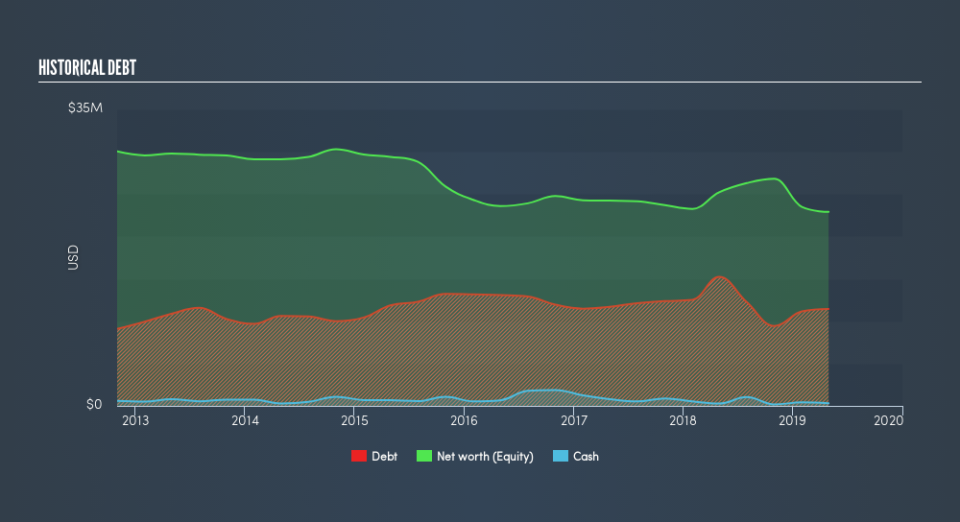Is Optical Cable (NASDAQ:OCC) A Risky Investment?

The external fund manager backed by Berkshire Hathaway's Charlie Munger, Li Lu, makes no bones about it when he says 'The biggest investment risk is not the volatility of prices, but whether you will suffer a permanent loss of capital.' So it might be obvious that you need to consider debt, when you think about how risky any given stock is, because too much debt can sink a company. Importantly, Optical Cable Corporation (NASDAQ:OCC) does carry debt. But the real question is whether this debt is making the company risky.
What Risk Does Debt Bring?
Debt and other liabilities become risky for a business when it cannot easily fulfill those obligations, either with free cash flow or by raising capital at an attractive price. Ultimately, if the company can't fulfill its legal obligations to repay debt, shareholders could walk away with nothing. While that is not too common, we often do see indebted companies permanently diluting shareholders because lenders force them to raise capital at a distressed price. Of course, the upside of debt is that it often represents cheap capital, especially when it replaces dilution in a company with the ability to reinvest at high rates of return. When we examine debt levels, we first consider both cash and debt levels, together.
See our latest analysis for Optical Cable
What Is Optical Cable's Net Debt?
The image below, which you can click on for greater detail, shows that Optical Cable had debt of US$11.4m at the end of April 2019, a reduction from US$15.2m over a year. On the flip side, it has US$310.7k in cash leading to net debt of about US$11.1m.
How Strong Is Optical Cable's Balance Sheet?
Zooming in on the latest balance sheet data, we can see that Optical Cable had liabilities of US$10.2m due within 12 months and liabilities of US$11.2m due beyond that. Offsetting these obligations, it had cash of US$310.7k as well as receivables valued at US$11.8m due within 12 months. So its liabilities total US$9.36m more than the combination of its cash and short-term receivables.
This deficit isn't so bad because Optical Cable is worth US$27.4m, and thus could probably raise enough capital to shore up its balance sheet, if the need arose. But we definitely want to keep our eyes open to indications that its debt is bringing too much risk. The balance sheet is clearly the area to focus on when you are analysing debt. But you can't view debt in total isolation; since Optical Cable will need earnings to service that debt. So when considering debt, it's definitely worth looking at the earnings trend. Click here for an interactive snapshot.
Over 12 months, Optical Cable saw its revenue hold pretty steady. While that's not too bad, we'd prefer see growth.
Caveat Emptor
Importantly, Optical Cable had negative earnings before interest and tax (EBIT), over the last year. Its EBIT loss was a whopping US$3.2m. When we look at that and recall the liabilities on its balance sheet, relative to cash, it seems unwise to us for the company to have any debt. Quite frankly we think the balance sheet is far from match-fit, although it could be improved with time. For example, we would not want to see a repeat of last year's loss of-US$3.8m. So in short it's a really risky stock. When I consider a company to be a bit risky, I think it is responsible to check out whether insiders have been reporting any share sales. Luckily, you can click here ito see our graphic depicting Optical Cable insider transactions.
Of course, if you're the type of investor who prefers buying stocks without the burden of debt, then don't hesitate to discover our exclusive list of net cash growth stocks, today.
We aim to bring you long-term focused research analysis driven by fundamental data. Note that our analysis may not factor in the latest price-sensitive company announcements or qualitative material.
If you spot an error that warrants correction, please contact the editor at editorial-team@simplywallst.com. This article by Simply Wall St is general in nature. It does not constitute a recommendation to buy or sell any stock, and does not take account of your objectives, or your financial situation. Simply Wall St has no position in the stocks mentioned. Thank you for reading.

